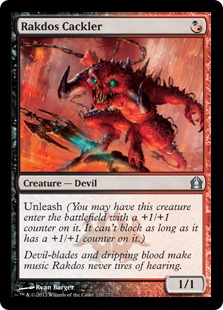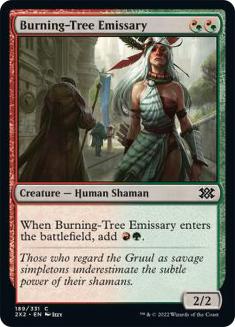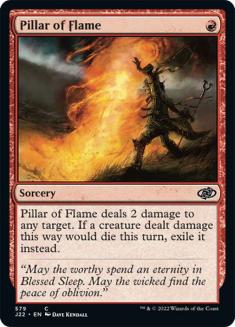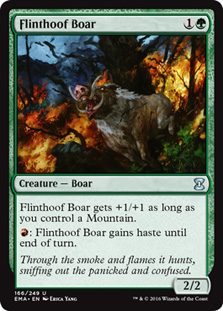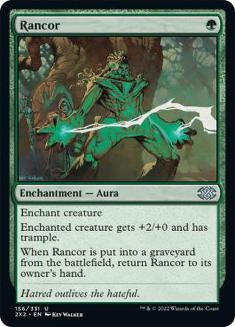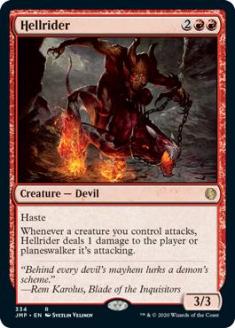Hello!
It’s been a while, but we have a brand new Standard format to tackle, so let’s dive right into it. I believe that this is an unbelievably balanced Standard format. Between aggressive Red, U/W/r Flash, Esper Control, Jund, and even a few wonky combo decks, there is a plethora of interesting and competitive options for this new Standard format.
With the addition of Gatecrash, we have seen an outbreak of a certain menace. Boros Reckoner will prove to be the most influential card in Standard from Gatecrash. The power level of this card is off the charts and will fundamentally change the way that decks are built. Expect there to be an increase in the amount of non-damage-based removal spells.
Aside on Hybrid Mana Cards:
Specifically, I want to point the finger at Deathrite Shaman and Boros Reckoner. Both of these cards are significantly better than anything that has been printed at their mono-colored cost. You would never see a single G creature printed with Deathrite Shaman’s abilities. Nor would you see the same card at a single B. However, hybrid mana makes it significantly easier to cast, and yet a format as powerful as Legacy has been taken over by this one-drop.
Would Boros Reckoner still be highly played if it required both red and white mana? In a word, yes. Being able to completely stonewall an aggressive creature rush with a single card is huge. Being a 3/3 for three is acceptable, but his ability is absolutely bonkers.
Picture this: you are on the play with a very explosive hand. Turn one, unleashed Rakdos Cackler, and turn two, two Burning-Tree Emissary into Pillar of Flame for their one-drop. Seems unbeatable right? Then, your opponent has the audacity to take their turn three, where they drop Boros Reckoner. Well shucks. Now you are faced with some incredibly tough decisions. Do you attack and push damage through, giving up two of your creatures for four damage? Do you hold back and hope to overwhelm the board until you can drop a Hellrider and win that way? You are in a horrible spot, where the best-case scenario is to two-for-one yourself with a Searing Spear.
The fact that you can choose when you want it to have first strike is also huge. Being able to decide whether you want it to simply kill a Thragtusk or if you want to trade with it and deal five is unreal. Boros Reckoner is the real deal, so get used to having to go through some complicated combat steps. It will be here for a while.
End Aside
I had yet to play a game of the new Standard, so I was chomping at the bit for the chance to jump in. Todd Anderson wrote a great article on the Premium side about Tomoharu Saito’s latest R/G Aggro deck, and it looked to be right in my wheelhouse. With news of Winter Storm Nemo, I was a little worried, but ended up driving up the morning of the event to find that the roads were unexpectedly clear, and arrived with no problems.
Here is the list that ended up playing.
Creatures (28)
- 4 Stromkirk Noble
- 4 Hellrider
- 4 Flinthoof Boar
- 4 Ash Zealot
- 4 Rakdos Cackler
- 4 Burning-Tree Emissary
- 4 Boros Reckoner
Lands (20)
Spells (12)
Sideboard

A few quick notes on the deck.
Be prepared to keep some ‘questionable’ hands. Take the following hand for example.
Regardless of if I was on the play or the draw, I would probably snap keep this against an unknown opponent. I might even utter an “Eh, YOLO,” with a head shrug as I do so. You are already taking a risk by playing an aggressive deck with Hellrider and only 20 lands. You knew what you were signing up for. A single land will turn on the majority of your hand, and you can get off to a very aggressive start. On the other hand, you might end up not actually playing a game of Magic. Those are the tradeoffs that you have, giving up land slots for spells. It is definitely not something for the faint of heart.
Let’s talk about what I liked about this build. Burning-Tree Emissary was a real all-star. This deck would simply not function without it. Outside of providing a free 2/2 attacker, you are getting a lot of flexibility. Killing a creature with Pillar, Rancoring your guy, adding a one-drop to your board, or simply fixing your mana for Flinthoof Boar. These are all options for turn two with your friendly neighborhood Emissary. And this is without mentioning chaining multiple Emissaries, which can feel a lot like the nut Affinity draws.
You have a very clear game plan. Play aggressively costed creatures and overwhelm your opponent. All of your creatures can threaten at least two damage a turn, and a majority of them have haste. Always be on the lookout for how to maximize your damage, and try to end the game as quickly as possible. The longer the game goes, the less likely you are to come out ahead.
There are certainly things that I would look to change about what I sleeved up this past weekend. Skullcrack in particular did a whole lot of nothing all day. Cards like this are usually much, much better in theory than they are in practice. Sphinx’s Revelation does not kill you because of the life gain. The five extra cards that they draw are what are going to do you in.
You can shrug off most Thragtusks because of Boros Reckoner. If I was that worried about Thragtusk, I would much rather have something like Mark of Mutiny to remove their blocker and get in for the same amount that they just gained. With the explosive starts that you get from playing this aggressive deck, games are oftentimes over before Thragtusk matters. Removing Skullcrack gives us the ability to shore up the rest of our matchups.
Not only is Blasphemous Act plus Boros Reckoner the cutest thing since Stuffy Doll and Shivan Meteor, it gives you an out against the nut draws of Ghost Pants (or Bant Hexproof, if you dislike fun). Having a reset button against an overwhelming army of hexproof dudes, battalions of Humans, or against Zoo’s menagerie is huge. You do run the risk of running into opposing Reckoners, which ‘might’ come up, but there are certain times where you need to swing for the fences and hope to 13 them out of nowhere.
Reckless Waif is a carryover from the previous Mono Red’s sideboards to combat the control decks. Do not fall into this trap. That matchup is pretty horrible, but your best chance of overcoming them is to basically empty your hand and cross your fingers. Flipping Waif is not the concern on their turn 1. However, if you want to be abusing your Burning-Tree Emissary, which you should want to do, you need to look elsewhere.
Flames of the Firebrand is an interesting card to consider. Being able to snipe a mana dork plus another creature can really help offset the ramp advantage that your opponent can gain, in addition to clearing the field for your beaters to get in.
Volcanic Strength was far and away the most impressive card for me. Look, we all know that with the completion of the shockland cycle, mana fixing is easier than it’s been in a while. This works in our favor in two different ways. First off, if our opponents want to take advantage of having perfect mana, oftentimes they will need to deal themselves a bit of damage, making our jobs easier. Secondly, their non-basics help turn on Volcanic Strengths. Fixing isn’t free, and we should punish people for wanting to get ambitious with their mana bases.
Here is what I would look to play if I were going to the StarCityGames.com Open Series in Cincinnati.
Creatures (28)
- 4 Stromkirk Noble
- 4 Hellrider
- 4 Flinthoof Boar
- 4 Ash Zealot
- 4 Rakdos Cackler
- 4 Burning-Tree Emissary
- 4 Boros Reckoner
Lands (20)
Spells (12)

The main change that you’ll notice is the promotion of Volcanic Strength to the maindeck. Think about what matchups that you’ll expect to play against. The mirror, Mono Red, Boros, Naya, Jund, U/W/r Flash all have Mountains that will turn an innocuous one-drop into a fearsome threat. Besides making your creatures unblockable, the additional two toughness goes a long way against those that want to control the board with Pillar or Searing Spear. Even your Stromkirk Noble gets out of Searing Spear range if it connects once. Be careful to not walk into a two-for-one, and you should be fine.
For the more risk-averse of you, I can see wanting to add a land at the expense of a Rancor of Volcanic Strength. But, then again, no gambol, no future.
Now, let’s take a look at some of the matchups and how to plan against them.
The Mirror
Ah yes, Reckoner on Reckoner combat math. If you’re like me, you want to bypass the hard thinking altogether and just Volcanic up your creatures. If you can’t, be prepared to spend a lot of time either A) in the tank trying to figure out the best possible trade you can make or B) cursing the day they ever printed such a frustrating card. I say most of this in jest; I much prefer the complexities of combat math than the usual ‘battlecruiser’ Magic that we have been accustomed to lately. However, there is always that moment when you empty your hand, only to be stymied by a single creature from your opponent.
Volcanic Strength is the best way to get ahead on board. Keeping your creatures out of direct damage range and providing a constant source of unblockable damage is key when both you and your opponent are cluttering the board with mostly irrelevant creatures.
Keep in mind that you can always keep a leash on your Rakdos Cackler if you need a blocker. This will come up often when you are on the draw facing down a turn-one Noble from your opponent.
Ghost Pants
The speed of their nut draws can rival your own. Gift of Orzhova is the main addition from Gatecrash, and they can still just race you with their enhanced hexproof threats. Basically, this matchup devolves into a race between two inconsistent decks that can threaten explosive starts.
In: 3 Blasphemous Act
Out: 2 Volcanic Strength, 1 Searing Spear
Most of these Ghost Pants decks will have certain non-hexproof threats (Silverblade Paladin or Fencing Ace) in addition to the Avacyn Pilgrims they rely on to get their turn-two Geist of Saint Traft or Loxodon Smiter. Keeping in your removal helps you slow them down and can go to the dome in a pinch. Blasphemous Act is really an “Oh *$&@” button that can get rid of their threats that you can’t target. That is the primary function, but come on; we all know you really just want to shoot them for 13.
Jund
I feel that this a fairly even matchup, but we know that Jund is the most customizable deck in the format. If they want, they can switch things around and have an abundance of answers to your threats, notably Abrupt Decay. They have a lot of answers for the variety of different viable decks, and they will have to make some choices. If they plan on beating up the control decks with Liliana and Rakdos’s Return, you can go underneath them and win the early game. If they get to the point where they can Kessig Wolf Run a Vampire Nighthawk, you need to have an answer quickly, or you’re going to be in a lot of trouble.
In: 2 Volcanic Strength, 1 Blasphemous Act, 1 Mizzium Mortars.
Out: 2 Pillar of Flame, 2 Rancor
It feels repetitive, but you really only have one gear. You want to be the aggressor, hitting them for every bit of damage possible. Save your Searing Spears for cards like Vampire Nighthawk or Olivia Voldaren; they are your only way of dealing with these game changers. Post board, they have tons of ways to stabilize against your early creatures, and they can try and overload the board against you. If you can’t win early, hopefully you’ve done enough damage that a Hellrider can steal the game for you, or you can sweep the board and start a top decking war.
U/W/r Flash
This is your nightmare matchup. If they ever have a Pillar, Snapcaster that Pillar, then Azorius Charm your next creature, you are so far behind that you really can’t come back. They utilize their mana and spells so efficiently, and it will seem a lot like they can’t ever lose to you. I’m not going to sugar coat it. It is going to be tough. Augur of Bolas conveniently blocks everything except for Flinthoof Boar, Reckoner, or Hellrider. If aggressive decks like our R/G Aggro become an overwhelming majority of the metagame, I can very easily see myself dusting off my Snapcaster Mages and Restoration Angels.
In: 2 Volcanic Strength
Out: 2 Pillar of Flames
Look, we have to get lucky to win. Hope that their removal spells don’t match up well with the threats that we draw. Keep your fingers crossed that they miss on their Augurs and don’t have a Charm for your suited-up creatures—you can overwhelm them early and close out games with a Hellrider. Pillar does nothing against any of their creatures, so that’s an easy one to take out. This matchup is one of the biggest reasons to avoid playing R/G Aggro, but fortunately, it does not make up a large part of the metagame for now.
Let’s be honest, we all know why you would want to play this. Todd Anderson built it, so it must be good. If you are looking for a solid, aggressive deck with some unbeatable draws, this is where you want to be. If you like taking risks or gambling on an ambitious land count, sleeve this up. If you like a lot of downtime in between matches, this is what you want to play. It has been a long time since I have shuffled up an aggressive deck, and the change of pace is nice. If you can handle the swings, you will definitely have a lot of fun playing this.
My eyes, and the rest of the world, will be watching the game’s best and brightest for their take on this new format. Keep your eyes peeled for what they bring to the table (or just follow Saito on Twitter), and join me in rooting for Team StarCityGames.com. And, c’mon GerryT, it’s time to Top 8 one.
As always, thanks for reading.


